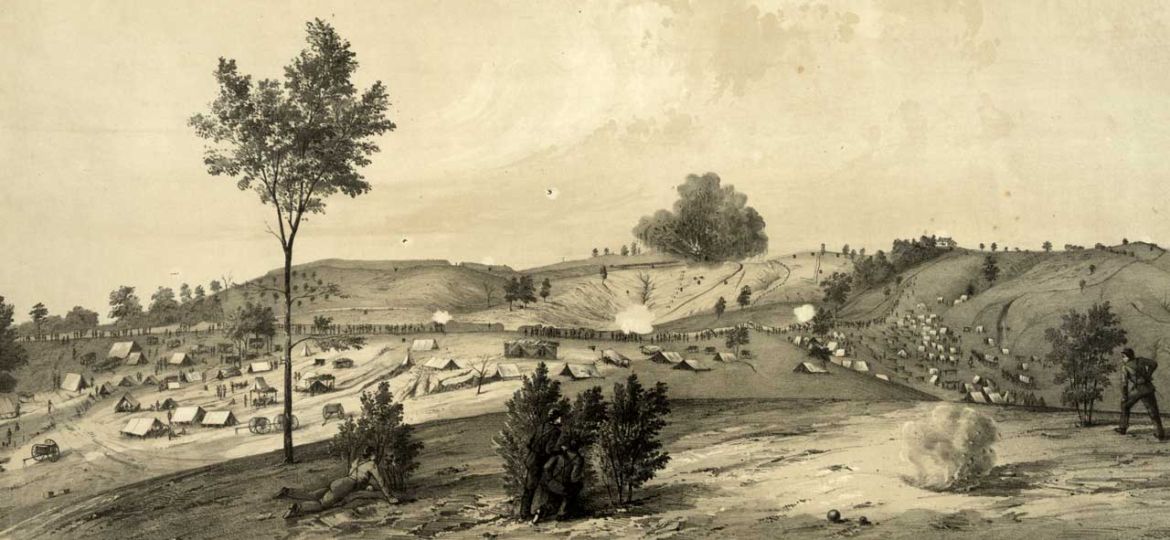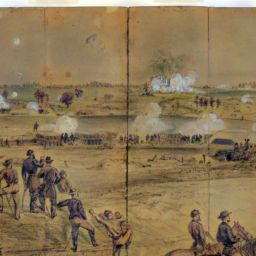
American Civil War, Western Theatre, Vicksburg campaign. By June 24, 1863, the siege of Vicksburg, Mississippi, had lasted some 33 days.
On May 19, Major General Ulysses S. Grant’s first attack of his Army of the Tennessee against Vicksburg’s defenses had failed. On May 22, a second assault also failed against the defensive works of the prized Confederate port city. Grant officially ordered his commanders on May 25 to begin “reducing the enemy” by siege, but the siege’s de facto start followed immediately after the repulse of the May 22 attack.
Ulysses S. Grant’s Daring Dash Through Mississippi to Vicksburg
Siege warfare presented a starkly different kind of combat than the soldiers of Grant’s army had recently known during the campaign to capture Vicksburg. Donald L. Miller explains in Vicksburg: Grant’s Campaign That Broke the Confederacy, that before besieging Vicksburg, Grant’s army had undertaken warfare marked by fast movement and clashes between forces on open battlefields:
After [crossing the Mississippi River from Louisiana and] landing in Mississippi on April 30, 1863, Grant had conquered space and time, hostile terrain and climate, without adequate cavalry and reliable maps. Most of his men had made the march on five day’s rations, and none had tents…. But under Grant’s resolute leadership, there was little grumbling or complaining, perhaps because the general . . . “shared the hardships of the common soldier, living on hardtack and sleeping on the ground”
…..
In eighteen days, Grant’s army had marched nearly two hundred miles; won five battles — four in six days’; inflicted a loss of 5,787 killed, wounded and missing; compelled the abandonment of two Confederate strongholds; captured the capital of Mississippi; chased [Gen. John] Pemberton’s army inside Vicksburg; and positioned his own army between the only two rebel forces in the state. Along the way, he suffered only 4,379 casualties, among them 695 killed. It was a tactical and strategic masterwork, and the decisions that decided the outcome had to be made in a flash, without consulting staff, other commanders, or his superiors in Washington. (413–414)
Impatient Waiting Game at Vicksburg
But now, the two static armies, Pemberton’s within Vicksburg and Grant’s surrounding it, faced each other from within trenches and behind breastworks. Now, an impatient waiting game ensued. General Grant hoped that his forces’ relentless artillery bombardments against Vicksburg, combined their blockading of the possible routes by which supplies could reach Vicksburg, would compel the Confederate garrison to surrender to him. He could not wait forever. Grant knew that given enough time, another Confederate army would gather, in eastern Mississippi, and attack him in an attempt to relieve Vicksburg.
Life In Vicksburg While Besieged by U.S. Forces, 1863
A resident of Vicksburg, Edward S. Gregory, in the 1879 work The Annals of the Civil War Written by Leading Participants North and South, compiled by the Philadelphia Weekly Times, wrote the following about life under siege in Vicksburg:
Even the [Union artillery] fire [against] the lines [of Confederate troops garrisoning Vicksburg] was not confined to them in its effects, for hardly any part of the city was outside the range of the enemy’s artillery from any direction except the south…. Just across the Mississippi [River], a few days after the lines were closed, seven eleven-and thirteen-inch mortars were put in position…. Twenty-four hours of each day these preachers of the Union made their touching remarks to the town. All night long their deadly hail of iron dropped through roofs and tore up the deserted and denuded streets. It was a feature of their practice that early in the night their favors would be addressed to one part of the city, and afterward changed so as to reach the cases of persons in other parts who had gone to bed in fancied security. Those who could forget the deadly design and properties of these missiles might admire every night the trail which they made across the western heavens; rising steadily and shiningly in great parabolic curves, descending with ever-increasing swiftness, and falling with deafening shriek and explosion; hurling in many a radius their ponderous fragments.
…..
The straits to which the garrison were reduced are known, in part…. [But the] citizens must have had less; and where they got that from was a mystery. Business, of course, was suspended. There were some stores that had supplies, and at these prices climbed steadily in a manner suggestive of the prophecy of Jerusalem’s undoing. A barrel of flour at last came to sell for one thousand dollars;…but worse than the figure were the two later facts—that nobody had the money and then nobody had the flour.
I have spoken of the wretched expedients to which families resorted in the hope of safety. Vicksburg hangs on the side of a hill…. Its soil was light and friable, and yet sufficiently stiff to answer the purpose of excavation. Wherever the passage of a street left the face of the hill exposed, into it and under it the people burrowed, making long ranges and systems of chambers and arches within which the women and young took shelter…. Sometimes the caves were strengthened by pillars and wooden joists, and beds and furniture were crowded in them…. They made good shelter against the flying fragments of the bombs, and this was no small matter. It was rather a point of honor among men not to hide in these places, which were reserved for the women and children.
…..
Considering the constant danger and the many narrow escapes, it is a great wonder that the casualties among the non-combatants were so few. I know of but one, and that was not fatal; the loss of an arm by Mrs. Major Reid, while bringing her children under shelter from a sudden storm of shells. There were doubtless others, but I have sought in vain to obtain the facts and names. (117–119)
IMAGE
Full size below with explanatory caption, cropped above.
SOURCES
McClure, Alexander Kelly, ed. The Annals of the Civil War Written by Leading Participants North and South. Philadelphia: Times Pub. Co., 1879. Perseus Digital Library.
Miller, Donald L. Vicksburg: Grant’s Campaign That Broke the Confederacy. Simon & Schuster, 2019. Kindle.

















